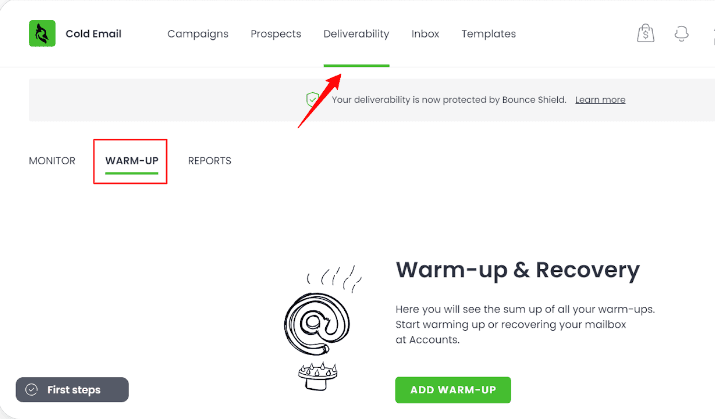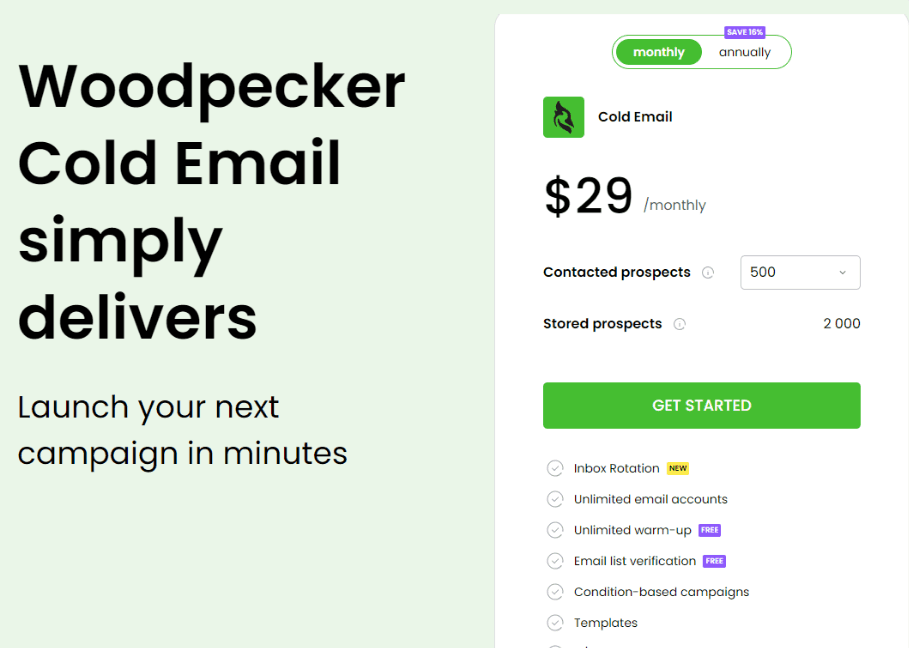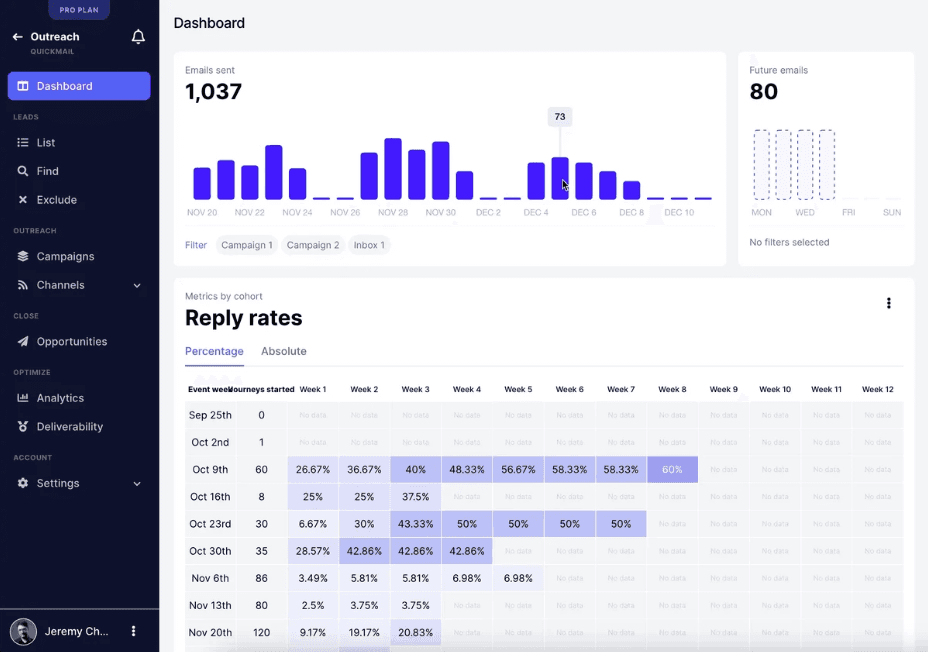Tools
Woodpecker vs Quickmail: Best Email Outreach Tool
Discover the ultimate showdown between Woodpecker and QuickMail! Compare their features, benefits, and suitability for your business.
Jul 16, 2024

Understanding Woodpecker and Quickmail
When diving into the world of cold email outreach, it's essential to compare tools that streamline your process. Two popular options are Woodpecker and QuickMail. Both software solutions help automate your email campaigns, enabling you to focus more on creating meaningful connections and generating leads.
Woodpecker
Woodpecker, launched in 2015 by Matt Tarczynski and Maciek Ciesl, offers a robust email prospecting system integrating well-known tools like Calendly, Slack, and Hunter. Perfect for businesses looking to automate follow-ups and track interactions effectively, Woodpecker provides several key features and pricing plans.
Key Features:
Automated Follow-Ups: Woodpecker ensures no lead falls through the cracks by automating your follow-up emails.
Analytics and Tracking: Get detailed insights into your email performance, helping you refine your strategy.
Compatibility: Seamlessly integrates with Gmail and Microsoft Outlook, making it easy to use with your existing email setup.
Agency System: Ideal for agencies, this feature helps monitor client outreach campaigns.
Pricing:
Basic Plan: $54 per email slot per month, allowing you to send up to 1,500 emails.
Agency Plan: $79 per email slot per month, catering to more extensive needs.
QuickMail
QuickMail focuses on assisting businesses in automating and optimizing their email outreach campaigns. Though its features and functionalities are somewhat different from Woodpecker, it aims to achieve similar goals of boosting productivity and enhancing connections.
Key Features:
Email Automation: Like Woodpecker, QuickMail automates your email campaigns, ensuring you never miss out on potential leads.
Smart Sequences: QuickMail's smart sequencing helps tailor your email flow based on recipient actions.
Team Collaboration: Enables seamless team collaboration, making it perfect for teams working together on outreach efforts.
Deliverability Features: Ensures your emails reach the recipient's inbox, reducing the risk of being marked as spam.
Pricing:
Information on QuickMail pricing isn't provided in the given context. But, you can explore their website for detailed pricing plans.
Common Mistakes and Misconceptions
Not Personalizing Emails: One common mistake is failing to personalize emails. Recipients can easily spot generic messages, leading to low engagement. Adding a touch of personalization—such as using the recipient's name or referencing past interactions—can make a big difference.
Overlooking Follow-Ups: Another misconception is that one email is enough. Studies show that follow-up emails improve response rates significantly. Tools like Woodpecker automate this process, ensuring you stay on top of follow-ups without manual intervention.
Practical Tips
Segment Your Audience: Tailor your emails based on audience segments. Not everyone will be interested in the same content. Segmenting your list allows you to deliver more relevant messages.
Test Subject Lines and Content: A/B testing different subject lines and email content can help identify what resonates best with your audience. Most email automation tools, like Instantly, offer these features.
Techniques and Methods
Cold Emailing: Cold emailing involves sending an unsolicited email to a potential lead. Tools like Woodpecker, QuickMail, and Instantly streamline this process. Make sure to maintain a friendly tone and avoid sounding too salesy.
LinkedIn Outreach: Another method is using LinkedIn for lead generation. Combining email outreach with LinkedIn messages increases your chances of connecting with potential leads.
Incorporating Best Practices
Use Email Scheduling: Tools like Woodpecker and QuickMail allow for email scheduling. Sending your emails at optimal times can lead to higher open rates.
Monitor Analytics: Keep an eye on your email analytics. Track open rates, click-through rates, and response rates to refine your strategy. These insights can guide your future outreach efforts.
Ensure Deliverability: Avoid common pitfalls like using too many links or large attachments, which can trigger spam filters. Tools like QuickMail have built-in features to enhance deliverability.
Be Pro Instantly
Integrate Instantly: Partnering with Growleady, Instantly provides another edge in cold email outreach. It's a powerful tool designed to complement your outreach efforts, making your campaigns more effective.
By understanding the functionalities and features offered by Woodpecker and QuickMail, you can make informed decisions on which tool aligns with your outreach needs. Implementing best practices and avoiding common pitfalls will further enhance your email campaigns, driving better results and lead generation.
Key Features of Woodpecker

Woodpecker stands out as a document automation tool that makes handling legal documents easier and more efficient. Let's jump into some of its standout features.
Efficiency in Document Automation
Woodpecker automates the tedious task of drafting legal documents in Word. Instead of manually creating and editing each document, you set up templates and use them to generate documents quickly. This helps reduce errors and save time, which can be a huge win in busy legal practices. Think of it like a copy machine for your documents — you make the master copy once and then make perfect duplicates every time you need one.
Integration Capabilities
Woodpecker doesn't work in isolation; it connects seamlessly with various tools and services. You can use it with Zapier, connecting it to thousands of other apps to streamline your workflow. Features like conditional logic and formulas allow you to create smart templates that adapt to different scenarios. Imagine being able to use one spreadsheet to fill in multiple client forms with just a few clicks — that's what these integrations can do for you.
Client Intake and Management
Efficient client intake is another big win with Woodpecker. The tool offers web-based questionnaires to capture client data directly. This data populates your Word templates automatically, making the entire intake process smooth and hassle-free. It's like having a digital assistant that gathers and organizes all the essential information for you, ready to go when needed.
Pricing and Subscription Models

Woodpecker's pricing is simple and transparent. With different subscription tiers, you can choose a level that fits your needs and budget. Whether you're a solo practitioner or part of a larger firm, you can find a plan with just the right amount of features and capacity.
Mistakes You Can Avoid:
Skipping integration capabilities can limit your efficiency.
Ignoring template setup might result in inconsistent documents.
Techniques and Best Practices
To get the best out of Woodpecker, start by setting up thorough templates and using the integration features available. Regularly update these templates and integrations to ensure they meet your current needs. The web-based questionnaires can be customized to match the specific information you need from clients, ensuring no detail is missed.
Remember, the key to effectiveness here is fully utilizing the automated features and integrating them with your existing systems. By setting it up right, you'll enjoy a streamlined, error-free document creation process that saves time and headaches.
Key Features of Quickmail
Speed and Real-Time Data Processing

QuickMail provides real-time reports and analytics, enabling you to monitor the performance of your email campaigns as they happen. This feature is invaluable for making timely adjustments and ensuring you respond quickly to potential opportunities. Imagine you’re a pilot constantly monitoring your dashboard to keep your flight on course; QuickMail does the same for your email campaigns. Its speed and data processing capabilities save you from the guesswork, providing actionable insights that can help refine your strategies on the fly.
User Experience and Interface
QuickMail's user-friendly interface makes managing multiple campaigns a breeze. Everything is designed to be intuitive, so you won't struggle to find key features or understand navigation. Picture using a smartphone where all apps are organized clearly; that's the level of ease QuickMail offers. The central team inbox is another excellent feature, allowing you to track replies from a single place. This simplifies team collaboration, making it easier to stay on top of client communications and responses. Plus, the simplified version of certain features available in more expensive plans ensures you're getting the most bang for your buck without overwhelming complexity.
Customisability and Flexibility
Personalizing your emails is crucial for successful outreach, and QuickMail excels here. You can tweak emails to include attributes like name, title, and company, making each email feel personal and not just another template. Think of it like addressing a friend by name versus saying, "Hey, you"; the former is more engaging. QuickMail also supports A/B testing, letting you experiment with different email versions to see which performs best. This trial-and-error process can significantly enhance your campaign's effectiveness. With QuickMail, you get the flexibility to adapt and find the winning formula for your outreach efforts.
Common Mistakes and Misconceptions
A common mistake is neglecting the personalization of your emails. It's easy to fall into the trap of sending generic messages, thinking volume will yield results. But, personalized emails have higher open and response rates. Another misconception is ignoring the importance of real-time data. Without leveraging this feature, you may miss crucial moments to engage. Finally, many users overlook the importance of A/B testing. Skipping this means you’re potentially missing out on discovering the most effective way to reach your audience.
Practical Tips and Techniques
To avoid common mistakes, always personalize your outreach. Use the recipient's name, mention their company, or touch on their pain points. When it comes to real-time data, make it a habit to check your analytics regularly. If something’s not working, adjust promptly. For A/B testing, don't just stop at one cycle. Keep testing different variables to see what works best under various conditions. You might find one email works great on a Tuesday but not on a Friday, for example.
Best Practices
To incorporate best practices, start by setting up a few A/B tests for your campaigns. Monitor these tests using QuickMail’s real-time analytics and make adjustments as necessary. Personalize your emails as much as possible without making them look like generic templates. Keep iterating based on what the data tells you, and you’ll likely find a winning combination faster. Remember, tools like QuickMail are designed to make your job easier, but the work doesn’t stop at setup; continual refinement is key to success.
Final Thoughts
When comparing tools like Woodpecker and QuickMail, it’s crucial to align your choice with your team’s specific needs and workflow. QuickMail's features, especially its real-time data processing, user-friendly interface, and customizability, make it a robust choice for those looking to boost their email outreach effectiveness. If you're using Instantly for your cold email needs, pairing it with QuickMail can give you an edge in managing and optimizing your campaigns. Each tool has its strengths; leveraging the right features can set you on a path to reaching and converting more leads through effective, personalized outreach.
Comparative Analysis: Woodpecker Vs Quickmail
Choosing the right email outreach tool can significantly improve your lead generation efforts. Let’s jump into how Woodpecker and Quickmail stack up against each other.
Performance and Reliability Comparison
QuickMail takes the lead with advanced features that elevate campaign efficiency. Its inbox rotation, email warm-up, and AI personalization help maintain high deliverability rates and ensure messages land in your prospects' inboxes, not their spam folders. Detailed analytics provide actionable insights for refining your campaigns. But, some users report occasional technical glitches that might disrupt workflows.
Woodpecker stands out for its streamlined cold email processes. It offers powerful automation, inbox rotation, email verification, and AI-driven personalization, which are valuable for maintaining high engagement rates. All these features come at no extra cost, making it a robust tool for email workflows. Woodpecker integrates seamlessly with popular CRMs, ensuring a smooth transition across platforms.
Cost Effectiveness and Value for Money
When it comes to pricing, Woodpecker and QuickMail cater to different budget levels. Woodpecker’s plans start at $49 per month for the Basic plan, making it accessible for smaller teams. The higher-tier Expert plan, aimed at large enterprises, provides additional features but comes with a steeper price tag. Some users feel the cost is high, especially if their team is small or just starting out.
QuickMail, while offering a range of advanced features, might also seem pricey to smaller teams. The investment can be justified by the efficiency gains and the potential increase in leads generated. Comparing the two, Woodpecker offers more value for money for those just getting started, while QuickMail’s extensive features might be worth the higher cost for more established teams.
Suitability for Different Business Sizes
Small Businesses and Startups: Woodpecker is ideal for smaller teams and startups thanks to its cost-effective pricing and user-friendly interface. The automation features help save time and resources, allowing you to focus more on strategy and less on manual tasks.
Medium to Large Enterprises: QuickMail becomes more appealing with its robust analytics and multichannel outreach capabilities. If your business requires integration with various CRM tools and sophisticated campaign optimization, QuickMail’s feature set can provide significant advantages.
Practical Tips and Best Practices
Avoid Common Mistakes: One mistake many make is neglecting personalization. Both tools offer AI-powered personalization—use it. Another common error is ignoring real-time data; make sure to analyze campaign performance regularly and adjust accordingly.
Techniques and Methods: Leverage email warm-up features to enhance deliverability. Rotate inboxes to avoid spam filters, especially if you're sending many emails. Use the detailed analytics provided by these tools to run A/B tests and continually refine your outreach strategies.
Incorporate Best Practices: Start with a clear strategy. Define your target audience and craft personalized messages. Use the automation features to schedule follow-ups but ensure your communication feels personal rather than automated. Regularly verify your emails to maintain a clean list and improve deliverability.
How Instantly Aligns
If you’re also exploring options like Growleady, an Instantly partner, know that Instantly excels in cold email campaigns as well. It provides an array of features like email verification, warm-up, and detailed analytics. Ensuring high deliverability and engagement rates, Instantly integrates with tools like Growleady, making it a robust option for scaling your outreach efforts effectively.
Conclusion
Choosing between Woodpecker and QuickMail boils down to your specific business needs. If you prioritize streamlined processes and CRM integrations, Woodpecker is a strong contender, especially for smaller teams looking for cost-effective solutions. On the other hand, QuickMail offers robust features for larger enterprises, focusing on speed and real-time data processing. Both tools have their strengths, so consider your team's size, budget, and campaign goals. Leveraging personalization, real-time data, and best practices like A/B testing will enhance your email outreach efforts regardless of your choice. Also, integrating partner tools like Instantly can further optimize your campaigns.
Frequently Asked Questions
What are the main features of Woodpecker?
Woodpecker offers automated follow-ups, document automation, and seamless integration with various CRMs, making it ideal for streamlined email campaigns.
How does QuickMail enhance email campaigns?
QuickMail focuses on speed, real-time data processing, and customization, making it suitable for enterprises needing advanced features for efficient campaign execution.
Which tool is more cost-effective, Woodpecker or QuickMail?
Woodpecker is more cost-effective for smaller teams, whereas QuickMail, with its extensive features, is more suited for larger enterprises.
What common mistakes should be avoided in email outreach?
Avoid neglecting personalization and real-time data in your campaigns for better engagement and responses.
What best practices should be followed for successful email outreach?
Leverage A/B testing, email warm-up, and personalization to maximize the effectiveness of your email campaigns.
How do Woodpecker and QuickMail compare in terms of performance and reliability?
QuickMail excels in advanced features for campaign efficiency, while Woodpecker stands out for its seamless process integration and reliability with CRMs.
Are there any tools recommended for email verification and warm-up?
Yes, the article mentions Instantly as a partner tool that offers features like email verification and warm-up to help scale your outreach effectively.
Which email outreach tool is better for large enterprises?
QuickMail is better suited for large enterprises due to its robust features and extensive customization options.

